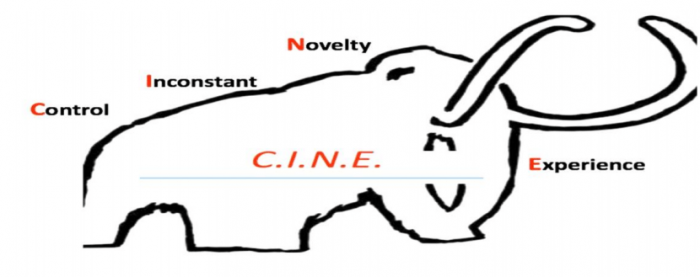
Since the 1960s, thousands of researches have been conducted in different sectors (immunology, oncology, neuropsychology, etc.) on the multiple factors involved in each phase of stress, and the impact of stress on health. But there is still much to be discovered, especially about the links between the mind and the brain, and, therefore, between psychology and physiology. For example, the stressor is the moment at which a physical, mental, social, or emotional stimulus occurs and it is necessary to adjust. The stimulus can be minor (contravention) or important (relocation), positive (marriage) or negative (conflict), exceptional (surgical procedure) or constant (an overloaded schedule), planned (an examination) or unexpected (an accident). Stress can also be physiological, and it can occur through events such as a medication or an injury since the body has to change its metabolism to react (Grant et al., 2014). Lack of stimulation can also create stress.

Fig 1: Image courtesy Nessaibia Issam.
Currently, we are mainly concerned with lifestyle stress and more particularly psychological stress (Wan et al., 2014). The human brain’s response system makes no distinction between stress related to real danger and a serious threat to survival, so-called absolute stress, and stress that doesn’t involve a threat to the individual, relative stress (Nazeri et al., 2015). For example, someone in the middle of a traffic jam, realizing that his or her meeting will be very late, is also stressed. His physiological response to stress is the same as if there was a mammoth in front of him (Fig.2).

Figure 2. C.I.N.E: Four ingredients of a stressor. You feel that you have less or no control over the situation. Something is happening — this completely inconstant thing. It’s also something new that you’ve never experienced before. Image courtesy Nessaibia Issam.
According to Marin et al, we have what it takes to deal with stress, but when you experience it about five times a day, problems can emerge. Researchers suggest that our stress response system is simply not programmed to be permanently activated. In the long-term, it can even lead to exhaustion of the body (Lupien et al., 2018). The intensity of the stress response depends on the message sent by the brain to the endocrine glands, and thus on the mind’s perception of the stimulus in question, seeing it as more or less dangerous, demanding, or constraining (LaDage, 2015). For example, a delay of five minutes does not usually create stress, unless we think we will miss the train, or if the brain imagines another catastrophic scenario, which may be the case if we place a great deal of importance on punctuality.
Negative attitudes or unrealistic expectations also give rise to stress problems. We tend to ignore it, but the stress reactions are normal and useful in many circumstances “good stress.” For example, the level of performance at the time of a task is improved during a certain amount of stress, as this would help stimulate motivation, help us better judge the parameters of the situation, and prepare accordingly. On the other hand, when stress reactions are intense or prolonged, even in everyday situations, it negatively affects social and occupational functioning. Furthermore, even after the stress factor has disappeared, the nervous system is slow to initiate the necessary relaxation reaction (Herman et al., 2015; Levi, 2016) (Fig.1).
Stress response is largely a question of personality, attitude, and life experiences (Ge et al., 2014). The intensity of the stress response depends essentially on the message sent by the brain to the endocrine glands, and therefore on the person’s perception of the situation in question — seeing it as more or less dangerous, demanding, or compelling (Henry and Stephens, 2013; McEwen et al., 2015). According to the work of psychologists Lazarus and Folkman, the mental process started with the appearance of a stressor includes two stages (Dudenhöffer and Dormann, 2013; Folkman, 2013):
- Evaluate the danger of a stimulus: How “bad” is it for me? The answer would determine by an impressive number of factors: temperament, education, social norms, culture, past experiences, values, etc. It is obvious for the most part such assessment is done unconsciously, using highly subjective perceptions, thoughts, emotions, concepts, and reasoning.
- Evaluate our available resources as they may be of various kinds:
- Physical Resources: Do I have health, strength, and energy?
- Material resources: Can I find the money, the tool?
- Social Resources: My friends, my brother, my colleague — can they help me?
- Psychological Resources: Am I able? Do I deserve such an effort?
- And one of the most problematic: Do I have time?
If the answers to these questions are too negative, the signal sent by the brain to the metabolism will be at a high alarm level. Individuals differ in their response to stress. The study of inter-individual differences often tackled by an attempt to classify into different “adaptive style,” including psychological, behavioral and, more rarely, physiological parameters (Bonanno and Burton, 2013). In human psychology, epidemiological studies have established correlations between the “adaptive style” of individuals, the level of perceived stress, and some immune measures (Klaus, 2014; Lagraauw et al., 2015; Powell et al., 2013). According to the Rosenman and Friedman criteria, it is possible to define two behavioral reactivity profiles called A and B. Type A individuals (hyperactivity, impatience, precipitation) have a higher sympathetic response to B during physical or psychological stress and have a higher risk of cardiovascular disease than B (Glass and Carver, 2013).
The epigenetic factors that can intervene in the ontogeny of the personality are multiple. An increasing number of studies show the importance of the perinatal environment on the development of the fetus and/or newborn in mammalian species (Bleidorn et al., 2014). The aggressions suffered by the animal during the perinatal period can have long-term consequences on its endocrine, immune, or behavioral development (Bleidorn et al., 2014; Zijlmans et al., 2015). Prenatal stress causes motor delays in the young, reduces exploratory behavior, and affects learning abilities and fear extinction (Wilson et al., 2013). Exposure to high doses of maternal or pharmacological glucocorticoids is associated with increased responsiveness of the corticotropic axis in young people and also in adults. The endocrine response to stress is greater (in amplitude and/or duration) than that developed by individuals who have not been exposed to glucocorticoids during their fetal development. This increased reactivity is partly due to an alteration of the negative glucocorticoid feedback on the corticotropic axis (Beijers et al., 2014; Bingham et al., 2013).
These findings are described in the article entitled Stress as an immunomodulator: liver X receptors maybe the answer, recently published in the journal Inflammopharmacology.
References:
- Beijers, R., Buitelaar, J.K., de Weerth, C., 2014. Mechanisms underlying the effects of prenatal psychosocial stress on child outcomes: beyond the HPA axis. European child & adolescent psychiatry 23 (10), 943-956.
- Bingham, B.C., Rani, C.S., Frazer, A., Strong, R., Morilak, D.A., 2013. Exogenous prenatal corticosterone exposure mimics the effects of prenatal stress on adult brain stress response systems and fear extinction behavior. Psychoneuroendocrinology 38 (11), 2746-2757.
- Bleidorn, W., Kandler, C., Caspi, A., 2014. The behavioural genetics of personality development in adulthood—Classic, contemporary, and future trends. European Journal of Personality 28 (3), 244-255.
- Bonanno, G.A., Burton, C.L., 2013. Regulatory flexibility: An individual differences perspective on coping and emotion regulation. Perspectives on Psychological Science 8 (6), 591-612.
- Dudenhöffer, S., Dormann, C., 2013. Customer‐related social stressors and service providers’ affective reactions. Journal of Organizational Behavior 34 (4), 520-539.
- Folkman, S., 2013. Stress: appraisal and coping, Encyclopedia of behavioral medicine. Springer, pp. 1913-1915.
- Ge, Y., Qu, W., Jiang, C., Du, F., Sun, X., Zhang, K., 2014. The effect of stress and personality on dangerous driving behavior among Chinese drivers. Accident Analysis & Prevention 73, 34-40.
- Glass, D.C., Carver, C.S., 2013. Environmental stress and the Type A response. Advances in Environmental Psychology: Volume 2: Applications of Personal Control 2, 59.
- Grant, K.E., McMahon, S.D., Carter, J.S., Carleton, R.A., Adam, E.K., Chen, E., 2014. The influence of stressors on the development of psychopathology, Handbook of developmental psychopathology. Springer, pp. 205-223.
- Henry, J.P., Stephens, P.M., 2013. Stress, health, and the social environment: A sociobiologic approach to medicine. Springer Science & Business Media.
- Herman, J.P., Maroun, M., Richter-Levin, G., 2015. Good stress, bad stress and very bad stress. Stress (Amsterdam, Netherlands) 18 (3), 267-268.
- Klaus, H.D., 2014. Frontiers in the bioarchaeology of stress and disease: Cross‐disciplinary perspectives from pathophysiology, human biology, and epidemiology. American journal of physical anthropology 155 (2), 294-308.
- LaDage, L.D., 2015. Environmental change, the stress response, and neurogenesis. Integrative and Comparative Biology 55 (3), 372-383.
- Lagraauw, H.M., Kuiper, J., Bot, I., 2015. Acute and chronic psychological stress as risk factors for cardiovascular disease: Insights gained from epidemiological, clinical and experimental studies. Brain, behavior, and immunity 50, 18-30.
- Levi, L., 2016. Stress and Distress in Response to Psychosocial Stimuli: Laboratory and Real-Life Studies on Sympatho-Adrenomedullary and Related Reactions. Elsevier.
- Lupien, S., Juster, R.-P., Raymond, C., Marin, M.-F., 2018. The Effects of Chronic Stress on the Human Brain: From Neurotoxicity, to Vulnerability, to Opportunity.
- McEwen, B.S., Bowles, N.P., Gray, J.D., Hill, M.N., Hunter, R.G., Karatsoreos, I.N., Nasca, C., 2015. Mechanisms of stress in the brain. Nature neuroscience 18 (10), 1353.
- Nazeri, M., Shabani, M., Ghotbi Ravandi, S., Aghaei, I., Nozari, M., Mazhari, S., 2015. Psychological or physical prenatal stress differentially affects cognition behaviors. Physiology & Behavior 142, 155-160.
- Powell, N., Tarr, A., Sheridan, J.F., 2013. Psychosocial stress and inflammation in cancer. Brain, behavior, and immunity 30, S41-S47.
- Wan, H.C., Downey, L.A., Stough, C., 2014. Understanding non-work presenteeism: Relationships between emotional intelligence, boredom, procrastination and job stress. Personality and Individual Differences 65, 86-90.
- Wilson, C.A., Vazdarjanova, A., Terry Jr, A.V., 2013. Exposure to variable prenatal stress in rats: effects on anxiety-related behaviors, innate and contextual fear, and fear extinction. Behavioural brain research 238, 279-288.
- Zijlmans, M.A., Korpela, K., Riksen-Walraven, J.M., de Vos, W.M., de Weerth, C., 2015. Maternal prenatal stress is associated with the infant intestinal microbiota. Psychoneuroendocrinology 53, 233-245.









